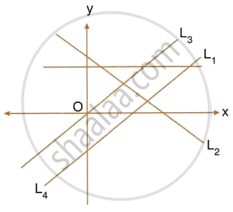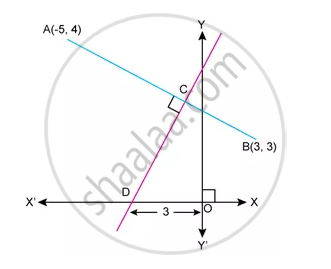Advertisements
Advertisements
प्रश्न
Find the equation of the perpendicular bisector of the line segment obtained on joining the points (6, −3) and (0, 3).
उत्तर
Let A = (6, −3) and B = (0, 3).
We know the perpendicular bisector of a line is perpendicular to the line and it bisects the line, that it, it passes through the mid-point of the line.
Co-ordinates of the mid-point of AB are
`((6 + 0)/2, (-3 + 3)/2)`
= `(6/2, 0)`
= (3, 0)
Thus, the required line passes through (3, 0).
Slope of AB = `(3 + 3)/(0 - 6) = 6/(-6) = -1`
∴ Slope of the required line = `(-1)/("slope of AB") = 1`
Thus, the equation of the required line is given by:
y − y1 = m(x − x1)
y − 0 = 1(x − 3)
y = x – 3
APPEARS IN
संबंधित प्रश्न
A (5, 4), B (-3, -2) and C (1, -8) are the vertices of a triangle ABC. Find the equations of the median AD and line parallel to AC passing through the point B.
The equation of a line is x – y = 4. Find its slope and y-intercept. Also, find its inclination.
Is the line x – 3y = 4 perpendicular to the line 3x – y = 7?
The line 4x − 3y + 12 = 0 meets x-axis at A. Write the co-ordinates of A. Determine the equation of the line through A and perpendicular to 4x – 3y + 12 = 0.
The points A, B and C are (4, 0), (2, 2) and (0, 6) respectively. Find the equations of AB and BC. If AB cuts the y-axis at P and BC cuts the x-axis at Q, find the co-ordinates of P and Q.
Match the equations A, B, C and D with the lines L1, L2, L3 and L4, whose graphs are roughly drawn in the given diagram.
A ≡ y = 2x;
B ≡ y – 2x + 2 = 0;
C ≡ 3x + 2y = 6;
D ≡ y = 2

Find the point on the X–axis which is equidistant from A(–3, 4) and B(1, –4).
Line PQ is parallel to line RS where points P,Q,R and S have
co-ordinates (2, 4), (3, 6), (3, 1) and (5, k) respectively. Find value of k.
Find Equation of CD

A line segment joining P(2, –3) and Q(0, –1) is cut by the x-axis at the point R. A line AB cuts the y-axis at T(0, 6) and is perpendicular to PQ at S.
Find the:
- equation of line PQ
- equation of line AB
- coordinates of points R and S.
